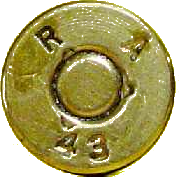Ysterhout Dot Net
After years of flawless operation and thousands of rounds, my one press started malfunctioning on the eject.
The problem began with the odd round not ejecting, which I just ignored, then progressed over time to every other round not ejecting, which was extremenly frustrating. At no time did I consider that the press was faulty, I just assumed I was not doing something right, and in too much of a hurry to try figure out what.
Initially, it also seemed that the problem was more pronounced with smaller rimless cases, and the larger rimless cases were not affected. Over time, the problem was occuring irrespective of caliber, and also began to affect rimmed cases.
The rim of the case seemed to be binding on the ejector, and it got to the point where I needed to manually remove every loaded round from the shellplate. On examining the ejector, I noticed that the vertical edge facing the case rim had worn down to convex. The cases were riding over the ejector instead of being deflected off the shellplate. I disassembled the press, removed the sub-plate, spot welded the ejector to build it up again, and filed it down to size and shape with a dremel.
Hornady would have shipped me a new sub-plate, but it takes weeks to get to this part of the world, and I needed it fixed right away.
A few months later, my second press started doing the same thing [ video link below ]. This video illustrates the problem :
I was curious as the to cause of the problem, this being my second press with the same symptoms at more or less the same age and similar overall loaded round count.
I wanted to see if the problem could be solved without spot-welding the ejector and reshaping it.
During the discovery process, I attempted to recreate the old wire ejector, and while doing that I observed that if the base of the round was pressed down on the sub-plate, ejection was always flawless.
I then checked the clearance between the shellplate and the sub-plate, and found that there was enough extra space for the case rim to ride up over the ejector, binding the shellplate and causing the ejection failure.
In my case, the ejector was 0.7mm high at the unworn part, and the groove on the underside of the shellplate that it travels in is 1.2 mm.
After verifiying that the shellplate hex screw was in fact tight, I removed the shellplates from both presses and compared the position of the drive hub relative to the sub-plate on both presses. I saw that on the press with the problem, the drive hub was permanently and prominently raised above the sub-plate, and very importantly, there was no slack on it, it was fixed in place as if it was press-fit to the drive shaft.
This is now two problems, a drive hub too far above the sub-plate, and a worn ejector.
The drive hub does need to be a fraction higher than the sub-plate, and I will explain why in the following pages.
 Debugging the Lock-n-Load EzJect
Debugging the Lock-n-Load EzJect


